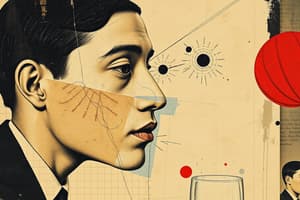Podcast
Questions and Answers
What defines contemporary art?
What defines contemporary art?
- Art that imitates traditional styles without innovation.
- Art produced by an artist historically over many decades.
- Art created today that reflects current global perspectives. (correct)
- Art that is restricted to individual experiences only.
Which of the following best describes appropriation in contemporary art?
Which of the following best describes appropriation in contemporary art?
- Creating new art without using any existing sources.
- Direct copying of historical artworks.
- Incorporating existing images to make new content. (correct)
- Using only original ideas and techniques.
How do contemporary artists relate to the elements of art?
How do contemporary artists relate to the elements of art?
- They utilize elements to convey ideas, values, and emotions. (correct)
- They employ elements to express personal emotions without meaning.
- They ignore traditional elements entirely.
- They use elements only to imitate past artworks.
What is a 'found object' in the context of contemporary art?
What is a 'found object' in the context of contemporary art?
What aspect of contemporary art is emphasized with negative and positive space?
What aspect of contemporary art is emphasized with negative and positive space?
What is a common source of stolen images in appropriation art?
What is a common source of stolen images in appropriation art?
Which principle is NOT typically associated with contemporary art?
Which principle is NOT typically associated with contemporary art?
How can artists appropriate images or objects?
How can artists appropriate images or objects?
Which element contributes to the interrelationship between arts and their elements?
Which element contributes to the interrelationship between arts and their elements?
What aspect is often emphasized in performance art?
What aspect is often emphasized in performance art?
In what way does contemporary art reflect changing times?
In what way does contemporary art reflect changing times?
Which of the following is NOT a theme commonly interpreted in performance art?
Which of the following is NOT a theme commonly interpreted in performance art?
What element can be combined with performance art?
What element can be combined with performance art?
What is implied about the use of pre-existing artwork in appropriation?
What is implied about the use of pre-existing artwork in appropriation?
What does hybridity in art primarily refer to?
What does hybridity in art primarily refer to?
Which of the following activities is NOT commonly associated with performance art?
Which of the following activities is NOT commonly associated with performance art?
In the context of technology in art, what does the term 'new media art' encompass?
In the context of technology in art, what does the term 'new media art' encompass?
How does appropriation challenge the boundaries of accepted imagery in art?
How does appropriation challenge the boundaries of accepted imagery in art?
Which of these is an example of hybridity in art?
Which of these is an example of hybridity in art?
What aspect of technology has impacted the art world since the 1960s?
What aspect of technology has impacted the art world since the 1960s?
How has the relationship between physical experience and technology changed in contemporary art?
How has the relationship between physical experience and technology changed in contemporary art?
What is one characteristic of performance art as described?
What is one characteristic of performance art as described?
How can space be described in the context of art?
How can space be described in the context of art?
Which best describes negative space in art?
Which best describes negative space in art?
What does the term 'site-specific art' imply?
What does the term 'site-specific art' imply?
Why is space considered a central aspect of visual arts?
Why is space considered a central aspect of visual arts?
What does positive space generally refer to?
What does positive space generally refer to?
What effect can artists achieve by manipulating sizes of objects in a composition?
What effect can artists achieve by manipulating sizes of objects in a composition?
Which of the following best defines 'flash mobs' in the context of performance art?
Which of the following best defines 'flash mobs' in the context of performance art?
Flashcards are hidden until you start studying
Study Notes
Overview of Contemporary Art
- Represents art produced by artists today, reflective of modern experiences and global context.
- Sensitive to social, political, and cultural changes, establishing relevance through new techniques and ideas.
Key Objectives in Understanding Contemporary Art
- Evaluate art forms using elements and principles.
- Identify and analyze the elements and principles that shape contemporary art.
- Recognize how these artistic components convey ideas, values, and emotions.
Elements and Principles of Contemporary Art
- Key aspects that guide the creation and interpretation of contemporary art include:
- Appropriation
- Performance Art
- Use of Space
- Hybrid materials
- Technology in art
Appropriation
- Involves creating new content by combining existing images from various sources such as art history, media, and popular culture.
- Allows artists to borrow and reinterpret, blending past and present art forms.
- Can evoke personal associations and political discussions through the selected imagery.
- Challenges the value of original works, asking if appropriation devalues or defaces the source material.
Performance Art
- A dynamic art form, often characterized by live presentations that can include music, dance, and visual arts.
- Engages with social themes like poverty and commercialism while emphasizing spontaneity and chance.
- Evolves from simple personal explorations to complex, site-specific, and multimedia presentations.
Space in Art
- Visual art utilizes space as an essential component, which can transform environments through installations and performances.
- Differentiates between positive space (occupied by subjects) and negative space (background areas).
- All visual arts manipulate space to guide audience perception, influencing interpretations of scale and relationships within the artwork.
Negativity and Positivity in Art
- Negative space enhances the subject's prominence by providing context and contrast.
- Positive space focuses on the main subject of the artwork, such as figures in portraits or landscapes.
Hybridity
- Describes the blending of unconventional and diverse materials to create new artworks.
- Example uses include non-traditional items like coffee for painting or crayons for sculpture.
Technology in Contemporary Art
- Encompasses the integration of digital tools and mass production in the creative process.
- Engages with modern platforms such as social media for sharing and dissemination, transforming artists' outreach.
- The evolution of art since the 1960s includes new media art, which merges creative expression with technology's capabilities.
Conclusion
- Contemporary art embodies a transformation in creativity, emphasizing interconnectivity among various art forms and their elements in reflecting current realities.
Studying That Suits You
Use AI to generate personalized quizzes and flashcards to suit your learning preferences.




